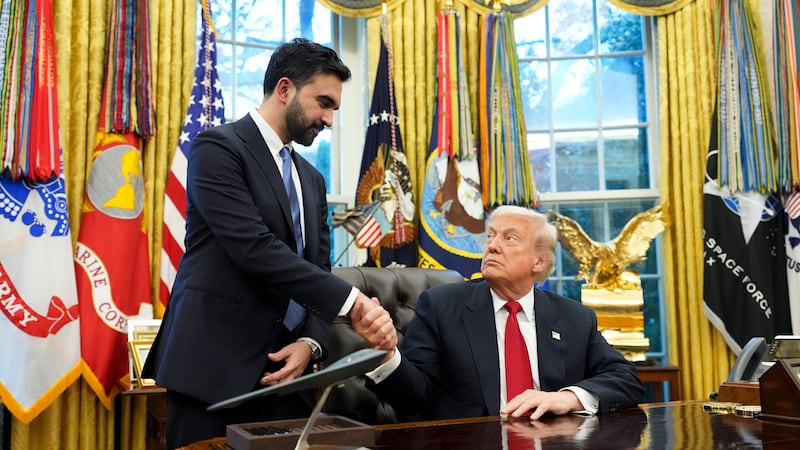The financial rock lifted by the Forvis Mazars audit firm’s long-awaited report on a bombshell €350,000 transfer from a jockeys’ charity fund to the Irish Horseracing Regulatory Board has also supplied an unnerving glimpse into political wriggling between the two bodies charged with running the sport.
If the 15-month wait between the report being commissioned and publicly revealed can be put in a better-late-than-never file, the IHRB response to Tuesday’s publication resonated with an urgent desire to put the whole matter behind it.
Mazars went through six years of the regulator’s financial records and found no other financial transaction breaches bar the “grave financial matter” first revealed to the world by the IHRB’s chief executive Darragh O’Loughlin in front of the Dáil’s Public Accounts Committee in June of last year.
That was when we were told the IHRB’s chief financial officer, Donal O’Shea, was on voluntary leave, where he stayed for over a year until quietly resigning during the summer. Until this week, queries on the matter were swerved by reference to the upcoming report, resulting in a vacuum filled with all kinds of speculation.
READ MORE
In comparison to some of the wilder hypothesising, the report is a dry, carefully formulated, legalled-to-an-inch-of-its-life, summation of an accounting juggle that only the naive or disingenuous can pretend is unheard of in other organisations.
A redundancy and early retirement scheme published by Horse Racing Ireland and open to IHRB staff saw some leave the regulator, none more prominent than its former chief executive Denis Egan, who left in 2021 with an extravagant package worth €384,870.
That was €141,000 more than the scheme’s conditions allowed. But Egan’s package was negotiated through an international services firm and resulted in him getting over €242,000 through HRI and €141,880 from the bodies that make up the IHRB.
Four months later, in January, the €350,000 was transferred from the Jockeys’ Emergency Fund to the IHRB to make up for “urgent cash flow pressures”. This was after Egan had gone and before O’Loughlin was appointed. According to the report, O’Shea effectively went on a solo run, told nobody above him in the IHRB, nor any JEF trustee, before the money got put back in April.
O’Loughlin’s response on Tuesday was replete with pledges about lessons having been learned, new processes in place, with corporate buzzwords about transparency and a focus on the future sprinkled on top. No one up the IHRB chain of command knew anything about it, the report says. All of which begs the question as to why not?
Those at the top take responsibility for what goes on in the ranks. It’s part of the job. Whatever about the report’s slalom through the minutiae, in an overall sense what kind of leadership structure expects to survive a series of blundering missteps such as these.
As well as dragging the sport’s name through the mud, it has breached the Charities Act, something that could provoke further examination by outside authorities. Far from taking consolation about a one-off incident, where no personal gain was involved, the IHRB faces a hefty tot counting the reputational damage suffered from having raided a charity to pay its own staff.
Reading the report, though, it’s hard to ignore how some of the administrative and management structures underpinning Irish racing look as haphazard as they are unwieldy. Some of the report’s recommendations about how the IHRB and HRI should carry out their functions in future could come from a bluffer’s guide to governance they’re so obvious.
At one point, the report outlines how some past and present IHRB board members said HRI had “implied” approval of Egan’s retirement pay-off through a previous payment. This was for nearly €250,000, hardly a throwaway sum worthy of just implication, particularly when both organisations have form when it comes to being less than collegial towards each other.
Sure enough, the HRI chairman, Nick Hartery, and the current and former CEOs, Suzanne Eade and Brian Kavanagh, told Mazars that Egan’s retirement payment wasn’t formally approved. The report said the use of public money for that payment wasn’t sanctioned in writing by HRI. But, despite all the crossed wires, it still somehow managed to get to him in the end.
It’s recommended that any future money given to the IHRB for future redundancy and retirement payments should require written approval from HRI. In one way, that’s simply a procedural matter. But it also underlines the regulator’s subservient role in an administrative system to a €2.5 billion industry that is portrayed as bloated and dysfunctional.
It begs the question as to when a potentially much more substantial and far-reaching review might be carried out as to the sustainability of a structure where one hand doesn’t appear to know what the other is doing sometimes.
Separating regulation from administration might work in theory. But public money requires accountability and solo runs, as outlined by Mazars, document how some private instincts were alive and well. A single accountable body works for most other major racing jurisdictions. Provision for two here could well be an increasingly hard proposition for Irish racing to pull off.
Something for the Weekend
Sakti is the number one hope for Ger Lyons in tonight’s Listed Cooley Stakes in Dundalk but will have to overcome being drawn widest of all. Her stable companion QUADRUPLE (6.30) likes to be prominent, and Gary Carroll won on his only spin on her in Limerick in June.
Tomorrow’s Listed contest in Doncaster sees TREASURE (3.10) carry some famous colours. Back on testing conditions, and after an encouraging return to action last month, she could secure some valuable winning black type.


















